
|
This page uses content from Wikipedia. The original article was at 2008 Atlantic hurricane season. The list of authors can be seen in the page history. As with Hurricane Wiki, the text of Wikipedia is available under the GNU Free Documentation License. |

The 2008 Atlantic Hurricane season produced 17 systems, 16 of which reached tropical storm strength, 8 reached Hurricane strength and 5 of those became major Hurricanes. The strongest of the storms was Hurricane Ike, which reached Category 4 status and had a minimum pressure of 935 mbar.
Timeline

Storms
Tropical Storm Arthur
Main Article: Tropical Storm Arthur (2008)
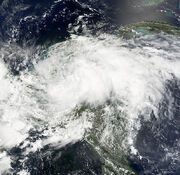
The storm formed late on May 30, 2008, and was designated Tropical Storm Arthur near the Belize coast early on May 31, developing out of the interaction between a tropical wave and the remnants of Tropical Storm Alma, and made landfall on Belize later that day. The system traversed the Yucatán Peninsula slowly and dissipated inland early on June 2. When Arthur made landfall on Belize it caused an estimated US$78 million worth of damage and killed 9 people, 5 of them directly. Arthur is the first reported tropical storm to form in May since Tropical Storm Arlene in 1981. Other systems have formed, but were subtropical (such as Andrea in 2007). Given Arthur's very short lifespan, Jeff Masters questions whether it would have been reported and named in the years prior to today's technology. The formation of Arthur also marks the first time that a named storm formed in May for two consecutive years.
Hurricane Bertha
Main Article: Hurricane Bertha (2008)

Early on July 1, a weak tropical wave emerged off the coast of Africa. By early the next day, a surface low developed and the wave became better organized.[13] The National Hurricane Center upgraded the system to Tropical Depression Two in the morning hours of July 3 after the system was able to maintain convection over its center for at least 12 hours. The depression organized further and developed two distinct bands of convection. Six hours after becoming a depression, it was upgraded to Tropical Storm Bertha, the second named storm of the season. The National Hurricane Center noted that this tropical cyclone was remarkably forecast up to a week in advance by many global computer models. After a bout of strengthening on July 6, Bertha was upgraded to a hurricane early on July 7 as satellite and microwave imagery indicated an eye feature had formed. It continued to strengthen that morning. Rapid intensification continued that afternoon and Bertha strengthened into a major hurricane with 125 mph (205 km/h) winds and a well-defined eye. The strengthening trend abated early on July 8, due to wind shear, and Bertha rapidly weakened back to a Category 1 hurricane that afternoon. Bertha again began to rapidly intensify on July 9 as a new eye had formed and the system became more symmetrical. The NHC upgraded Bertha to a Category 2 with winds of 105 mph (170 km/h) and stated that Bertha could intensify further to major hurricane status again, but instead weakened into an 85 mph (135 km/h) Category 1 hurricane. On July 12, Bertha slowed in movement, becoming almost stationary and by July 13 this slow movement weakened the storm to tropical storm strength. The storm brought rain and tropical storm-force winds to Bermuda on July 14, but no damage was reported. After slowly meandering to the east and then the southeast, Bertha regained hurricane strength on the 18th as it began accelerating towards the northeast. As it moved over cooler waters, it weakened slightly to a tropical storm late on July 19. It finally became extratropical on July 20 southwest of Iceland. Bertha is the longest-lived pre-August Atlantic tropical cyclone on record.
Tropical Storm Cristobal
Main Article: Tropical Storm Cristobal (2008)

A tropical disturbance located off the east coast central Florida formed on July 15. The system slowly developed into a Tropical Depression on July 18 while located 65 mi (105 km) to the south-southeast of Charleston, South Carolina. The depression gradually became better organized and was upgraded to Tropical Storm Cristobal the next day while located 225 mi (362 km) to the southwest of Cape Hatteras, North Carolina. Cristobal paralleled the North Carolina coastline for the next two days with minimal to no impact as most of the convection and wind was located on the eastern half of the storm. However, there was some heavy rainfall amounting up to 5 in (130 mm) in localized areas of southern North Carolina. On July 20, Cristobal began to move away from the coastline and began to intensify as it passed over the Gulf Stream. Cristobal peaked the next day with winds of 65 mph (105 km/h). As Cristobal moved closer to Nova Scotia, it began to lose its tropical characteristics. By July 23, Cristobal had transitioned into an extratropical cyclone.
Hurricane Dolly
Main Article: Hurricane Dolly (2008)
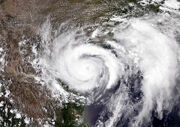
A strong tropical wave tracked across the Caribbean Sea in the third week of July. Despite producing strong convection and tropical storm-force sustained winds, it failed to develop a low-level circulation until July 20. That morning, reconnaissance aircraft found a low-level circulation and the system was declared Tropical Storm Dolly. This marked the fastest start of a hurricane season since 2005. It made landfall early on July 21 as a weak and disorganized tropical storm near Cancun, and emerged over the Gulf of Mexico later that morning. 17 deaths were reported in Guatemala from landslides caused by heavy rain on the fringes of Dolly. On July 22 at 4 p.m. CDT, it strengthened into the second hurricane of the season. It steadily strengthened that night into the morning of July 23 and reached Category 2 intensity. Dolly then weakened some before it made landfall at 1 p.m. CDT (1800 UTC) on South Padre Island as a Category 1 hurricane. Dolly caused no deaths in Texas; it did, however, become the most damaging hurricane to affect Texas since 2005's Hurricane Rita, with US$1.05 billion dollars in damage. It was also the most destructive hurricane to make landfall in Texas since 1983's Alicia, and was the fourth costliest Texas hurricane in history, behind Hurricane Rita, Hurricane Alicia, and Hurricane Ike later in the season. The remnant low caused flash flooding and two deaths in New Mexico before dissipating late on July 27.
Tropical Storm Edouard
Main Article: Tropical Storm Edouard (2008)

A shear line stalled in the northeastern Gulf of Mexico in early August as troughing aloft dug into the northeast Gulf of Mexico. This energy aloft helped to organize a surface low along the shearline early on August 2, which slowly organized over the following day. It strengthened into Tropical Depression Five before gaining intensity and being named Tropical Storm Edouard on August 3. The storm made landfall in Southeast Texas near Port Arthur on the morning of August 5 as a strong tropical storm. As it moved inland, the system weakened into a tropical depression by afternoon. The depression dissipated late on August 6 while inland over Texas.
Tropical Storm Fay
Main Article: Tropical Storm Fay (2008)

A vigorous tropical wave tracked into the northeastern Caribbean in mid-August. It produced heavy rain across the Leeward Islands and into Puerto Rico before tracking westward, while unable to develop a low-level circulation despite producing tropical storm-force winds. On August 15, a closed circulation was found and the system was declared Tropical Storm Fay. Later that day Fay produced heavy rains on the island of Hispaniola prompting a major flash flood threat. Fay crossed Hispaniola, Cuba, and hit south Florida beginning late on August 18, slowly tracking northeastward across the peninsula. Significant flooding resulted in much of eastern Florida, along with some wind damage. After crossing into the Atlantic, Fay turned westward again and crossed northern Florida on August 22. As it zigzagged from water to land, it became the first storm in recorded history to make landfall in Florida four times. Fay weakened into a tropical depression along the north coast of the Gulf of Mexico. Fay eventually became extratropical on the morning of August 27 while located over Tennessee. Fay was responsible for 36 deaths and at least $560 million in damage (2008 USD).
Hurricae Gustav
Main Article: Hurricane Gustav
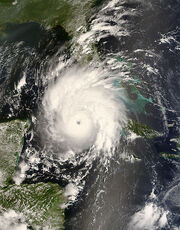
A disturbance developed in the deep tropical Atlantic in the fourth week of August. It tracked westward into the Caribbean Sea where it encountered more favorable conditions, and became a tropical depression on the morning of August 25, west of the Windward Islands. It rapidly intensified into Tropical Storm Gustav early that afternoon and into Hurricane Gustav early on August 26. Striking southwest Haiti, it weakened into a tropical storm on the evening of August 27 due to land interaction and slowed down considerably. It re-organized further south into a strong tropical storm once again on August 28 before speeding up and hitting Jamaica. Gustav killed 92 people in Haiti, the Dominican Republic, and Jamaica. It then was upgraded to a hurricane again during the late afternoon of August 29. On the morning of August 30, Gustav was upgraded to a major Category 3 hurricane. After intensification slowed for a few hours, another round of rapid intensification occurred and Gustav was upgraded to a Category 4 hurricane during a hurricane hunter flight around 1 p.m. EDT (1700 UTC), with 145 mph (215 km/h) winds. Continuing to intensify, it became a 155 mph storm that afternoon before landfall. Soon after Gustav made landfall in Cuba, firstly on the island of Isla de la Juventud and later on the mainland near Los Palacios in Pinar del Río Province, causing catastrophic damage, although it was difficult to estimate it; damage was later estimated at 3 billion dollars (2008 USD). It then emerged into the Gulf of Mexico on August 30, weakening into a Category 3 hurricane with 115 mph (185 km/h) winds. However, the hurricane was still large, and early the next day, it made landfall on Louisiana. At 8 a.m. CDT September 1 the storm weakened to Category 2 just before landfall. On September 4, Gustav was absorbed by a cold front while over the Ozarks. Gustav is responsible for 153 deaths and at least $6.6 billion in damage.
Hurricane Hanna
Main Article: Hurricane Hanna (2008)

Tropical Depression Eight formed on August 28 from a low pressure area east-northeast of the northern Leeward Islands. It was upgraded to a tropical storm later that day and named Hanna. On September 1, while Hanna was moving very near to the island of Mayaguana in the Bahamas, it was upgraded to Category 1 hurricane status. Hanna meandered around the southeastern Bahamas, weakening to a tropical storm while also dumping heavy rain on already-devastated Haiti. Hanna made landfall around Myrtle Beach, SC late on September 5, and quickly northeastward near the east coast of the United States as a tropical storm. Hanna transitioned into an extratropical cyclone as it moved offshore from Massachusetts early on September 7. At least 537 deaths were blamed on Hanna, primarily in Haiti.
Hurricane Ike
Main Article: Hurricane Ike
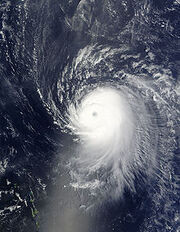
A tropical disturbance developed off the coast of Africa near the end of August. It tracked south of Cape Verde and slowly developed. On September 1 it became Tropical Depression Nine while west of the Cape Verde islands and intensified into a tropical storm later that day, when it was given the name Ike. Ike developed an eye late on September 3 as it underwent explosive intensification, as it strengthened from a tropical storm to a Category 4 hurricane in twelve hours with an estimated pressure drop of 43 millibars (1.3 inHg), from 991 to 948 millibars (29.3 to 28.0 inHg); and a 24 hour pressure drop of 61 millibars (1.8 inHg), from 996 to 935 millibars (29.4 to 27.6 inHg). Ike weakened back to a Category 2 hurricane before re-intensifying back to Category 4. It ripped across Great Inagua Island and Grand Turk Island, where 80% of the buildings on Grand Turk were severely damaged or completely destroyed. It weakened into a strong Category 3 and then re-strengthened once again at Category 4 late in the afternoon of September 7 as it headed for landfall on the northeastern coastline of Cuba that evening. In addition, the storm killed at least 74 people in Haiti and 2 people in the Dominican Republic. As Ike crossed Cuba on September 8 it weakened to a Category 1 hurricane and emerged into the Caribbean Sea, where it moved along or just off of the southern coast of Cuba. Ike killed 7 people as it traversed nearly the entirety of Cuba. It crossed into the Gulf of Mexico on September 9 and ballooned in size. Ike maintained a double eyewall structure across most of the Gulf of Mexico and continued to expand in size. It made landfall on Galveston Island on September 13 as a strong Category 2 hurricane, but its large size brought storm surge of over 12 feet (3.7 m) from Galveston Island eastward into southern Louisiana. The Bolivar Peninsula was worst affected by the surge, while Galveston Island (where waves topped the seawall) and the Port Arthur areas also saw extensive damage. Power was knocked out to most of the Houston area and windows were blown out of skyscrapers in downtown Houston. As Ike moved inland, it brought extensive flooding and wind damage throughout the Midwest and as far north as Pennsylvania. It became extratropical on September 14. Damage from Ike is estimated at $37.6 billion (2008 USD) of which $29.6 billion was in the US, the second most destructive U.S. hurricane on record, behind Katrina in 2005. At least 195 fatalities have been blamed on Ike, of which 112 were in the United States. It was the most destructive hurricane in Texas history. Ike was an extremely large and powerful storm. At one point, the diameter of Ike's tropical storm and hurricane force winds were 600 and 240 miles (965 and 390 km), respectively, making Ike the largest Atlantic hurricane ever recorded. Ike also had the highest Integrated Kinetic Energy (IKE) of any Atlantic storm. IKE is a measure of storm surge destructive potential, similar to the Saffir-Simpson Hurricane Scale, though it is more complex and in many ways more accurate. On a scale that ranges from 1 to 6, with 6 being highest destructive potential, Ike earned a 5.6. Ike lastly travelled through the US into southern Ontario, Canada, where record amounts of rainfall were recorded in several years. It was noted as the second most active tropical storm to reach the Canadian mainland since Hazel in 1954 which also traveled through southern Ontario. The storm then dissipated as it reached southern Québec on September 14.
Tropical Storm Josephine
Main Article: Tropical Storm Josephine (2008)

A tropical disturbance developed off the coast of Africa near the end of August. It tracked south of Cape Verde and slowly developed. On September 2 it became Tropical Depression Ten while south-southeast of the southernmost Cape Verde islands. The depression was upgraded to a tropical storm later the same day as it passed to the south of the Cape Verde islands. Strong wind shear weakened the system over the next few days, and it dissipated on September 6 without coming near any land. On September 7 the ex-Josephine disturbance regained some organization and regeneration seemed possible, but the low became exposed again and the NHC discontinued their statement about regeneration possibilities. The remnant lingered on for a few days, with a report on September 11 that it might regenerate, but dissipated without further action. As Josephine passed to the south of the Cape Verde islands on September 2, outer rain bands produced minor rainfall, totaling around 0.55 inches (14 mm). There were no reports of damage or flooding from the rain and overall effects were minor. Several days after the low dissipated, the remnant moisture from Josephine brought showers and thunderstorms to St. Croix where up to 1 in (25.4 mm) of rain fell. The heavy rains led to minor street flooding and some urban flooding. No known damage was caused by the flood.
Hurricane Kyle
Main Article: Hurricane Kyle (2008)

A strong tropical disturbance tracked across the northeastern Caribbean Sea in the third week of September. It meandered around Puerto Rico and Hispaniola, dumping torrential rains across the islands causing a significant amount of damage, despite never developing a closed circulation. By September 24, it began to track northward away from the islands and into the open Atlantic water, and it became a tropical storm on September 25, thus being named Kyle. Kyle was upgraded to a hurricane during the afternoon of September 27. It continued northward and maintained hurricane strength until landfall near Yarmouth, Nova Scotia in Canada late on September 28. A few hours later, Kyle became extratropical as the cold waters of the Bay of Fundy took effect. In general, Maritimers were spared the anticipated damage.
Tropical Storm Laura
Main Article: Tropical Storm Laura (2008)
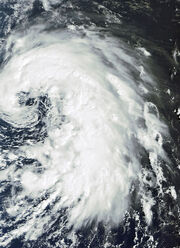
In the last week of September, a very large non-tropical system over the north-central Atlantic slowly moved westward away from the Azores. As it entered warmer waters, it slowly gained tropical characteristics and was declared Subtropical Storm Laura early on September 29. It became fully tropical the next day and was reclassified as Tropical Storm Laura. On October 1 it became "post-tropical" as it moved over cooler waters.
Tropical Storm Marco
Main Article: Tropical Storm Marco (2008)

Tropical Depression Thirteen formed from a very small but well-organized low in the Bay of Campeche on October 6. It rapidly intensified into Tropical Storm Marco with 65 mph (100 km/h) winds that afternoon. Marco made landfall near Veracruz, Mexico the next morning at the same intensity. Marco dissipated that night as the small circulation moved inland. At one point, tropical storm-force winds were estimated to extend only 10 miles (16 km) from the center, which makes it the smallest tropical cyclone on record.
Tropical Storm Nana

A tropical wave exited the coast of Africa on October 6, accompanied by a broad area of low pressure moving westward over the Atlantic Ocean. Initially there was little convection, until October 8 when thunderstorms increased. Three days later, Dvorak classifications began, and following the development of convective banding features on October 12, the NHC reported the low developed into a tropical depression around 0600 UTC; at the time, it was located about 795 mi (1,280 km) west of the Cape Verde Islands. Operationally, the NHC did not begin issuing advisories on the depression until it had become a tropical storm later on October 12, when satellite passes indicated sustained winds of 40 mph (65 km/h); as such, it was named Nana. The newly upgraded storm tracked west-northwestward in response to a ridge to its north. Little intensification took place due to increasing wind shear on the western side of the cyclone. The storm attained its lowest pressure of 1004 mbar (hPa; 29.65 inHg) around 0000 UTC on October 13. Within 12 hours of its peak intensity, Nana weakened to a tropical depression as shear continued to displace convection from the center. Upon weakening to a depression, it accelerated northwestward. After a brief burst of convection early on October 14, Nana degenerated into a non-convective remnant low pressure area. The remnants persisted until 1200 UTC on October 15, when it dissipated 945 mi (1,520 km) east-northeast of the Leeward Islands.
Hurricane Omar
Main Article: Hurricane Omar (2008)

A tropical disturbance in the eastern Caribbean Sea was in an area unfavorable for development in the second week of October. While drifting across the region, upper-level winds diminished enough for the tropical disturbance to strengthen and to develop into Tropical Depression Fifteen on October 13. It strengthened to Tropical Storm Omar the next day. Omar quickly strengthened into a 70 mph (110 km/h) storm that afternoon, and became a hurricane that night. It remained a hurricane through that night and it changed little in intensity through the next day, but that evening Omar intensified quickly and became a 115 mph Category 3 storm, and became a 125 mph (205 km/h) storm the next morning. In a discussion supplied by the National Hurricane Center, it stated that Omar may have peaked as a minimal Category 4 early that morning. This was later confirmed in November in their Running Best Track. However, wind shear and dry air quickly weakened Omar to a minimal hurricane that afternoon as it raced towards the northeast and soon it dropped to tropical storm strength. It then degenerated to a remnant low the next day. Omar caused at least $60 million in damage to the Lesser Antilles (2008 USD), and killed two people, both in Puerto Rico.
Tropical Depression Sixteen
Main Article: Tropical Depression Sixteen (2008)
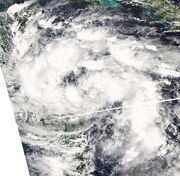
A vigorous disturbance in the western Caribbean slowly developed off the east coast of Nicaragua. It organized enough to become Tropical Depression Sixteen on October 14. Because the depression hugged the Honduras coast it prevented much strengthening. The disorganized center made landfall in Punta Patuca, Honduras on October 15. It dissipated inland that evening. Its remnants however became nearly stationary in the area between northern Costa Rica and southeastern Mexico and continued to produce locally heavy rains for several days. However, it did not regenerate. This storm caused about $150 million in damage (2008 USD), and killed at least 75 people.
Hurricane Paloma
Main Article: Hurricane Paloma

An area of low pressure became stationary in the Caribbean Sea without showing tropical development for several days at the beginning of November. Finally, on November 5 the low pressure system organized and became Tropical Depression Seventeen just east of Nicaragua. The next day it strengthened to become Tropical Storm Paloma then later, Hurricane Paloma. The following days proved to be a rarity in terms of tropical cyclone intensity in the month of November. This was seen when Paloma was upgraded to a Category 2, then later a Category 3 major hurricane, making it the first P named storm to reach major hurricane status in the Atlantic Basin. Paloma continued to strengthen and peaked with winds of 145 mph, making it the second strongest November hurricane behind 1999's Lenny, by the afternoon of the 8th, but Paloma weakened rapidly before making landfall as a Category 2 hurricane on the evening of November 8 near Santa Cruz del Sur, Cuba. On November 9, Paloma was downgraded to a tropical storm and then a depression. Later that evening, the storm finally met its demise as it transformed into a remnant low. Paloma caused up to $300 million (2008 USD) in damage to Cuba, and $15 million in damage to the Cayman Islands. In the spring of 2009 the WMO retired the name Paloma, making it the first retired P named storm in the Atlantic Basin.
Storm Names
The following names were used for named storms that formed in the North Atlantic in 2008. The list was the same as the 2002 list except for Ike and Laura, which replaced Isidore and Lili, respectively. The names Ike, Omar and Paloma were used for Atlantic storms the first time this year; the name Laura was previously used in 1971.
Retirement
On April 22, 2009, at the 31st Session of the World Meteorological Organization's Regional Association IV Hurricane Committee, the WMO retired the names Gustav, Ike, and Paloma from its rotating name lists. The names were replaced with Gonzalo, Isaias, and Paulette

